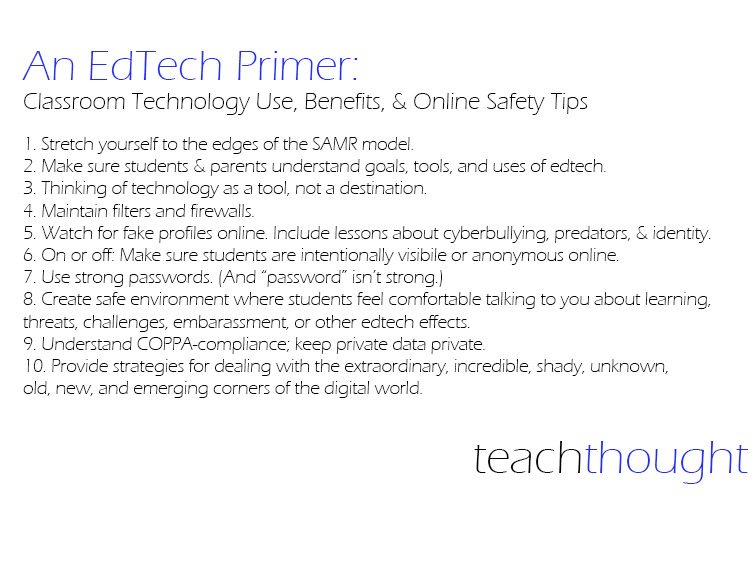 An EdTech Primer: Technology Use, Benefits, And Online Safety Tips
An EdTech Primer: Technology Use, Benefits, And Online Safety Tips
contributed by Amy Williams
Today, many parents can pinpoint one significant difference between their child’s education and our own–technology.
Granted, we overhear complaints about Common Core or standardized tests, but the major difference is the influx of technology in education–the internet, computers, apps, and social media. The chalkboards and film projectors, which were the height of technological advancement back in our day, are now obsolete and tucked away in the storage room collecting dust.
Different Kinds Of Learning Technology
Examples Of Technology In Education
Today’s classrooms are now decked out with Smartboards, computer labs, Ipads, student laptops, Powerschool, electronic textbooks, and more. In fact, many teachers are typically the first group to commonly implement and understand technology in “almost all areas of personal use”.
Here is a quick list of 12 popular apps and programs teachers use with students.
- Google Documents (Android, iOS)
- Twitter (Android, iOS)
- Grapher (Android)
- iTunes and iTunesU
- Dropbox (Android, iOS)
- eReader Programs (Such as Kindle on Android, or iBooks on iOS)
- Classroom Response Systems, or “clickers” (see various models and apps)
- Testing Programs (Accelerated Reader, Lexile, Accelerated Math, etc.)
- Nearpod (Android, iOS)
- Netflix (Android, iOS)
- YouTube (universal)
- Google (universal)
Educational Benefits
Recent data reveals that “78% of K-12 teachers and administrators believe technology has positively impacted the classroom and the productivity of students. Roughly 65% of educators surveyed also believe that students are more productive today than they were three years ago due to the increased reliance on technology in the classroom”.
Listed below are just a few of the benefits offered by technology:
- Technology can hold a child’s interest and encourage the mastering of skills through games and practice exercises that can adapt to their learning levels.
- Students are able to locate information and details for almost any topic without a trip to a library or days of research.
- Teachers are able to engage students and offer diverse platforms for to develop new concepts and show understanding.
- Technology allows richer details and experiences through multimedia.
- Social Media allows learning connections to form beyond the classroom.
- Students can create videos, web pages, blogs, e-projects and more for class projects.
- Technology allows you to publish and give real purpose to assignments.
Risks Associated With Online Activity
In the fast-paced world and ever-changing technology, it is important for educators to stay current and utilize technology that our students will encounter in life. This quest to utilize relevant technology in the classroom can raise some safety concerns.
Student safety is probably to most common concern with technology use. Over 90% of “technology coordinators, school administrators, and teachers support teaching cyber ethics, safety, and security in schools”. However, only 35% of teachers admit that their school districts implement and require teaching these concepts in the curriculum.
The real-time data collected from tests, “clickers”, and student feedback is valuable and has a place in the classroom. However, teachers need to realize that simply having a computer in the classroom to merely take tests is also a pitfall of technology. Teachers need to strive to extend beyond the norm and encourage real growth and research.
Due to the continuing development of the adolescent brain, teens are not always able to make responsible choices when granted the freedom offered by new technologies. However, educational technology can enrich the learning process in ways that once were impossible in a classroom.
9 Classroom Technology Safety Tips For Students & Teachers
Online safety is a very important factor to consider when using educational technology in the classroom. Teachers are no longer able to dazzle students with Speak’N Spells or a floppy disk of The Oregon Trail.
Here are a few tips to utilize to safely use technology in your classroom:
1. Stretch yourself to the edges of the SAMR model. Think SAMR model, or the stages of edtech disruption.
2. Make sure students & parents understand goals, tools, and uses of edtech.
3. Thinking of technology as a tool, not a destination.
4. Maintain filters and firewalls.
5. Watch for fake profiles online. Include lessons about cyberbullying, predators, & identity.
6. On or off: Make sure students are intentionally visibile or anonymous online.
7. Use strong passwords. (And “password” isn’t strong.)
8. Create safe environment where students feel comfortable talking to you about learning, threats, challenges, embarassment, or other edtech effects.
9. Understand COPPA-compliance; keep private data private.
10. Provide strategies for dealing with the extraordinary, incredible, shady, unknown, old, new, and emerging corners of the digital world.
Moving Forward
Worksheets and notes still have value in a classroom, but the unlimited learning potential technology can provide is in our grasp. It is important to know what the types of Internet usage are available and to possess an understanding of the potential gains or risks associated with these technologies.
Higher level thinking skills and concepts are able to be developed with a few simple clicks of a button or a swipe of a finger. Thankfully, learning will never be obsolete. As Albert Einstein said, “The day you stop learning is the day you stop living.”
9 Classroom Technology Safety Tips For Students & Teachers; An EdTech Primer: Technology Use, Benefits, And Online Safety Tips
